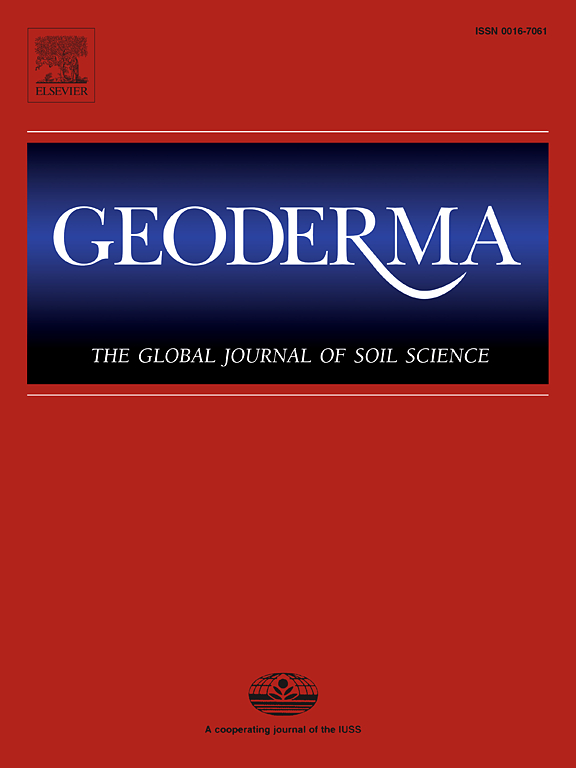放牧引起的非生物和资源变化驱动温带草甸草原土壤细菌和真菌群落的不同响应:对碳动态的影响
IF 6.6
1区 农林科学
Q1 SOIL SCIENCE
引用次数: 0
摘要
土壤微生物群落在维持草地生态系统功能中起着至关重要的作用,并受到放牧的强烈影响。然而,土壤微生物群落对放牧强度梯度的长期响应及其驱动机制仍未深入研究。研究了不同放牧强度(未放牧、轻度、中度和重度放牧)对呼伦贝尔羊草草甸草原土壤细菌和真菌多样性及组成的影响机制。利用双部网络来表示指示性物种变化,细菌群落沿着放牧强度梯度呈现出明显的演替,可能与土壤非生物条件(如土壤温度、淤泥)有关。相反,真菌群落在放牧强度梯度上表现出更离散的变化,挑战了真菌群落在干扰下更稳定的传统观点。真菌群落的变化与植被组成和地上生物量密切相关,反映了典型的自下而上的资源相关调控,比非生物条件沿放牧强度梯度的变化更具动态性。有趣的是,指标分析表明,较高的放牧强度使细菌和真菌组成向低营养(如Dothideomycetes、Sordariomycetes、Leotiomycetes、Chloroflexi、Thermoleophilia)和低营养(如腐生菌(Saprotrophs)、拟杆菌(Bacteroides)和subgroup_6)转变。这种转变反映了底物的枯竭,与观察到的生态系统呼吸抑制一致,意味着有机物分解较低。细菌和真菌响应的独特模式为放牧改变土壤细菌和真菌群落的潜在长期后果提供了新的见解,包括未来生长限制资源和土壤环境条件,以承受未来的干扰,这些干扰会不同地影响土壤细菌和真菌群落,从而调节土壤有机碳周转。此外,不同的富营养化和贫营养化基团对基质的亲和力改变了有效碳分解和顽固性碳分解,从而可能改变土壤碳循环和储量。本文章由计算机程序翻译,如有差异,请以英文原文为准。
Grazing-induced abiotic and resource changes drive distinct responses of soil bacterial and fungal community in temperate meadow steppe: Implications for carbon dynamics
Soil microbial communities play a crucial role in maintaining grassland ecosystem functions and are strongly influenced by livestock grazing. However, the long-term responses and driving mechanisms of soil microbial communities to grazing intensity gradients, remain largely unexplored. In this study, we investigated the mechanism of different grazing intensities (i.e., ungrazed, light, moderate and heavy grazing) affect the diversity and composition of soil bacteria and fungi in the Hulunbuir Leymus chinensis meadow steppe. Using a Bipartite network to represent indicative species shifts, bacterial community presented a clear succession along the grazing intensity gradient, likely linked to soil abiotic conditions (e.g. soil temperature, silt). In contrast, fungal community exhibited a more discrete shift along the grazing intensity gradient, challenging the traditional view that fungal community is more stable under disturbance. The shifts in fungal community were closely related to the vegetation composition and aboveground biomass, reflecting a typical bottom-up resource-related regulation, which were more dynamic than changes caused by abiotic conditions along the grazing intensity gradient. Interestingly, indicator analysis showed that higher grazing intensity shifted bacterial and fungal composition towards more oligotrophic (e.g. Dothideomycetes, Sordariomycetes, Leotiomycetes, and Chloroflexi, Thermoleophilia) and less copiotrophic (e.g. Saprotrophs, Bacteroides and subgroup_6). This shift reflects the depleted substrate and is consistent with the observed inhibition of ecosystem respiration, implying lower organic matter decomposition. The distinct patterns of bacteria and fungi responses provides novel insights into the mechanisms, through which grazing alters soil bacterial and fungal communities with potential long-term consequences, including future growth-limiting resource and soil environment conditions to withstand future disturbances, which affect soil bacterial and fungal communities differently and consequently modulate soil organic carbon turnover. Moreover, the different substrate affinity of copiotrophic and oligotrophic groups altered available and recalcitrant C decomposition, which may change soil carbon cycling and stocks.
求助全文
通过发布文献求助,成功后即可免费获取论文全文。
去求助
来源期刊

Geoderma
农林科学-土壤科学
CiteScore
11.80
自引率
6.60%
发文量
597
审稿时长
58 days
期刊介绍:
Geoderma - the global journal of soil science - welcomes authors, readers and soil research from all parts of the world, encourages worldwide soil studies, and embraces all aspects of soil science and its associated pedagogy. The journal particularly welcomes interdisciplinary work focusing on dynamic soil processes and functions across space and time.
 求助内容:
求助内容: 应助结果提醒方式:
应助结果提醒方式:


